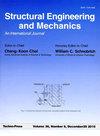Collapse resistance of steel frames in two-side-column-removal scenario: Analytical method and design approach
IF 2.2
4区 工程技术
Q2 ENGINEERING, CIVIL
引用次数: 1
Abstract
So far analytical methods on collapse assessment of three-dimensional (3-D) steel frames have mainly focused on a single-column-removal scenario. However, the collapse of the Federal Building in the US due to car bomb explosion indicated that the loss of multiple columns may occur in the real structures, wherein the structures are more vulnerable to collapse. Meanwhile, the General Services Administration (GSA) in the US suggested that the removal of side columns of the structure has a great possibility to cause collapse. Therefore, this paper analytically deals with the robustness of 3-D steel frames in a twoside- column-removal (TSCR) scenario. Analytical method is first proposed to determine the collapse resistance of the frame during this column-removal procedure. The reliability of the analytical method is verified by the finite element results. Moreover, a design-based methodology is proposed to quickly assess the robustness of the frame due to a TSCR scenario. It is found the analytical method can reasonably predict the resistance-displacement relationship of the frame in the TSCR scenario, with an error generally less than 10%. The parametric numerical analyses suggest that the slab thickness mainly affects the plastic bearing capacity of the frame. The rebar diameter mainly affects the capacity of the frame at large displacement. However, the steel beam section height affects both the plastic and ultimate bearing capacity of the frame. A case study on a sixstorey steel frame shows that the design-based methodology provides a conservative prediction on the robustness of the frame.钢框架在双柱拆除情况下的抗倒塌性能:分析方法和设计方法
迄今为止,三维钢框架的倒塌评估分析方法主要集中在单柱拆除的情况下。然而,美国联邦大厦因汽车炸弹爆炸而倒塌的事件表明,在真实的结构中可能会发生多根柱子的损失,其中结构更容易倒塌。与此同时,美国总务管理局(GSA)表示,拆除该结构的侧柱有很大的可能导致倒塌。因此,本文对三维钢框架在双柱拆除(TSCR)情况下的鲁棒性进行了分析研究。本文首次提出了分析方法来确定框架在除柱过程中的抗倒塌能力。有限元结果验证了分析方法的可靠性。此外,提出了一种基于设计的方法来快速评估由于TSCR场景的框架的鲁棒性。结果表明,该分析方法能较合理地预测TSCR工况下框架的阻力-位移关系,误差一般小于10%。参数化数值分析表明,板坯厚度主要影响框架的塑性承载力。钢筋直径主要影响框架在大位移下的承载力。而钢梁截面高度对框架的塑性承载力和极限承载力均有影响。对一个六层钢框架的实例研究表明,基于设计的方法对框架的鲁棒性提供了保守的预测。
本文章由计算机程序翻译,如有差异,请以英文原文为准。
求助全文
约1分钟内获得全文
求助全文
来源期刊

Structural Engineering and Mechanics
工程技术-工程:机械
CiteScore
3.80
自引率
18.20%
发文量
0
审稿时长
11 months
期刊介绍:
The STRUCTURAL ENGINEERING AND MECHANICS, An International Journal, aims at: providing a major publication channel for structural engineering, wider distribution at more affordable subscription rates; faster reviewing and publication for manuscripts submitted; and a broad scope for wider participation.
The main subject of the Journal is structural engineering concerned with aspects of mechanics. Areas covered by the Journal include:
- Structural Mechanics
- Design of Civil, Building and Mechanical Structures
- Structural Optimization and Controls
- Structural Safety and Reliability
- New Structural Materials and Applications
- Effects of Wind, Earthquake and Wave Loadings on Structures
- Fluid-Structure and Soil-Structure Interactions
- AI Application and Expert Systems in Structural Engineering. Submission of papers from practicing engineers is particularly encouraged.
 求助内容:
求助内容: 应助结果提醒方式:
应助结果提醒方式:


